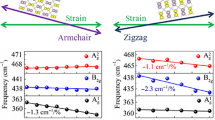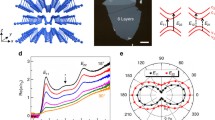For unstrained few-layer BP, a 1D tight-binding model accounting for the interlayer coupling can well describe the optical transitions, with only two relevant parameters: the monolayer band gap Eg and the interlayer coupling strength17,19. It is apparent that Eg depends on the in-plane strain, since it is merely determined by the intralayer bond. The dependence of interlayer vdW interaction on the in-plane strain is not clear yet. An intuition may imply that the interlayer coupling would be enhanced with in-plane tensile strain, since the interlayer distance typically decreases due to the Poisson effect. However, our experiment gives opposite result, as detailed in the following analysis. From 1D tight-binding model (see details in Supplementary Information), the shift rate of transition energy due to strain is
$$\frac{{{\mathrm{{d}}}E_{nn}}}{{{\mathrm{{d}}}\varepsilon }} = h - 2k\,\cos \left( {\frac{{n\pi }}{{N + 1}}} \right),$$
(1)
where ε is the applied biaxial strain, N is the layer number, n is the index of subband, h and k are fitting parameters describing the change rates of monolayer band-gap and vdWs interaction strength under strain, respectively. Based on this equation, we can conclude that the shift rate of transition energy is layer (N) dependent and transition index (n) dependent for k ≠ 0.
To extract the values of h and k, we used Eq. (1) to globally fit all of the experiment data, shown as the solid curves in Fig. 3a. The fitting values of h and k are 66 and −86 meV/%, respectively. The overall trend of the fitting curves is in reasonable agreement with the experiment data. The deviation of data points from the fitting curves is mainly attributed to the experimental uncertainty in determining the strain value. Of course, Eq. (1) does not take into account excitonic effects and other many-body interactions, which may compromise its accuracy. Nevertheless, the basic behavior is well captured by the model. Since h and k are in the same order of magnitude, the modification of vdWs interaction under in-plane strain contributes as significantly as that of intralyer bonding does to the tuning of the band structure. Previously, we experimentally determined the transition energy Enn = Eg0 − 2Δγ cos(nπ/(N + 1)), with Δγ = 880 meV, for unstrained few-layer BP17. We can see that 1% in-plane strain changes the interlayer coupling (Δγ) almost 10%, which is quite remarkable.
To further confirm our experimental results, we performed DFT calculations of the strain effect. The details of the calculation are presented in the section “Methods”. Figure 3b shows the DFT calculated shift rates for 1L, 2L, 3L, and 8L BP, in good agreement with our experiments (see Fig. 3a). The infinite lattice periodicity in the ab plane (in-plane) gives rise to dispersive bands, which have the band gap at Γ point. For those few-layer BPs, the interlayer vdWs interaction along the c-axis (out-of-plane) lifts the energy degeneracy at Γ, thus forming different groups of subbands. For example, we plot in Fig. 3c the lattice structure of a 2L BP, and in Fig. 3d the illustrative band structure of 2L BP and its evolution against strain. When an in-plane tensile strain is applied (see the right part of Fig. 3d), the increasing intralayer atomic distance and thus the decreasing intralayer interaction reduces the band width and enlarges the band gap. Moreover, our calculation also indicates a decrease of the interlayer interaction, since the subband splitting gets smaller. As a result, for the lower-index subband transitions (Enn, n < N/2) in the finite N-layer BP, both the decreasing intralayer and interlayer interactions contribute positively to the increasing Enn, giving a positive energy shift rate against the strain. However, for the higher-index transitions (Enn, n > N/2), the decreasing intralayer (interlayer) interaction yields a positive (negative) contribution to the Enn, making its shift rate smaller than the lower-index Enn. All these mechanisms are well captured by the DFT calculations: for a given few-layer BP, the energy shift rate of Enn gets smaller with the increasing index, and Enn can even become negative, e.g., E33 for 3L BP and Enn (n ≥ 5) for 8L BP. There is overall a quite good agreement between the DFT calculations and the experiments, as shown in Fig. 3a, b.
It should be emphasized that the fitting parameter k in Fig. 3a is negative. A negative k means a weakened interlayer coupling under tensile strain. This is rather astonishing, given that in-plane tensile strain typically compresses the sample in the out-of-plane direction due to the Poisson effect. Now we see that a shorter distance between layers gives a weaker vdWs coupling between them. How could this happen? In order to make sense out of it, we have to revisit the puckered lattice structure of few-layer BP.
According to the tight-binding model, the band structure in the vicinity of Γ point of the Brillouin zone in few-layer BP is mainly determined by three hop** parameters: two intralayer ones (\(t_{{\mathrm{||}}}^{\mathrm{1}}\) and \(t_{{\mathrm{||}}}^{\mathrm{2}}\)) and one interlayer one (t⊥)26, as illustrated in Fig. 3c. The hop** parameter t is generally related to the bond length r in the form of \(t \propto \frac{1}{{r^2}}\)27. It should be noted that the vdWs interaction between layers is a complicated and sometimes vague concept. Here we just capture the major contributing factor t⊥ for our discussion, and treat it on the same footing as in-plane bonds. For monolayer BP, the bandgap can be expressed as Eg = 4\(t_{{\mathrm{||}}}^{\mathrm{1}}\) + 2\(t_{{\mathrm{||}}}^{\mathrm{2}}\). While for 2L (or few-layer) BP, interlayer interaction (t⊥) also contributes to the band structure, and leads to the splitting of valence and conduction bands, resulting in two subband transitions: E11 and E22. The energy difference between E11 and E22 (Δ = E22 − E11) is proportional to t⊥26.
Based on the above analysis, one can directly understand how the band structure of 2L BP evolves with the in-plane biaxial strain. Under biaxial tensile strain, the absolute values of \(t_{{\mathrm{||}}}^{\mathrm{1}}\) and \(t_{{\mathrm{||}}}^{\mathrm{2}}\) both decrease. But it is still not straightforward to predict how Eg changes, since the two hop** parameters have different signs (\(t_{{\mathrm{||}}}^{\mathrm{1}}\) < 0, \(t_{{\mathrm{||}}}^{\mathrm{2}}\) > 0)26. However, the experiment results show that both E11 and E22 blueshift, indicating biaxial tensile strain induces an increase of Eg. Moreover, when tensile strain is applied, atoms connected by t⊥ are split apart laterally, since the two atoms are not in registry (one right above the other). More importantly, those two atoms are split apart vertically as well, even though the Poisson effect compresses the sample in the vertical direction, as shown by our DFT calculations (see Supplementary Fig. 9).
This unusual scenario originates from the puckered structure within each BP layer, which is constituted of two sub-layers. When biaxial in-plane tensile stain is applied, the average distance between two adjacent layers (D + d, shown in Fig. 3c) decreases due to the Poisson effect. According to the DFT calculations (Supplementary Fig. 9), when 1% biaxial tensile strain is applied, the interlayer distance (D + d) between two phosphorene layers decreases by 0.031 Å, corresponding to an out-of-plane Poisson’s ratio \(\nu = - \frac{{{\mathrm{{d}}}\varepsilon _z}}{{{\mathrm{{d}}}\varepsilon _{xy}}}\) ~0.5. However, at the same time, the distance between two sub-layers (d) within each layer decreases even more thanks to the puckered structure (0.087 Å, with 1% biaxial tensile strain, see Supplementary Fig. 9), causing an increased gap (D) between two layers (0.056 Å, with 1% biaxial tensile strain). As a result, the distance between the two atoms responsible for t⊥ increases, leading to the decrease of t⊥ and hence the decrease of interlayer interactions. The puckered structure of BP efficiently facilitates this counterintuitive phenomenon. Therefore, when the interlayer interaction decreases, the energy difference between E11 and E22 also decreases. Meanwhile, tensile strain leads to the blueshift of both E11 and E22, hence the shift rate of E11 is larger than that of E22, as illustrated in Fig. 3d. With above argument, we conclude that the higher the transition index is, the smaller the shift rate is. As demonstrated by DFT calculation in Fig. 3b, the shift rate even changes to negative sign when the subband index n is >5 for the 8L BP. The split subbands of few-layer BP provide us a unique platform to monitor the vdWs interactions under strain or other physical perturbations.
In summary, we systematically investigate the evolution of band structures in few-layer BP under in-plane biaxial strain. Our results show that strain effect of few-layer BP exhibits layer number and subband index dependence. This dependence is closely related to the tuning of interlayer coupling. Surprisingly, in-plane biaxial tensile strain weakens such coupling, which is counterintuitive. Indeed, it is the puckered structure of BP which facilitates this phenomenon. Our study paves the way for strain engineering of vdWs interactions in few-layer BP and other 2D materials.





